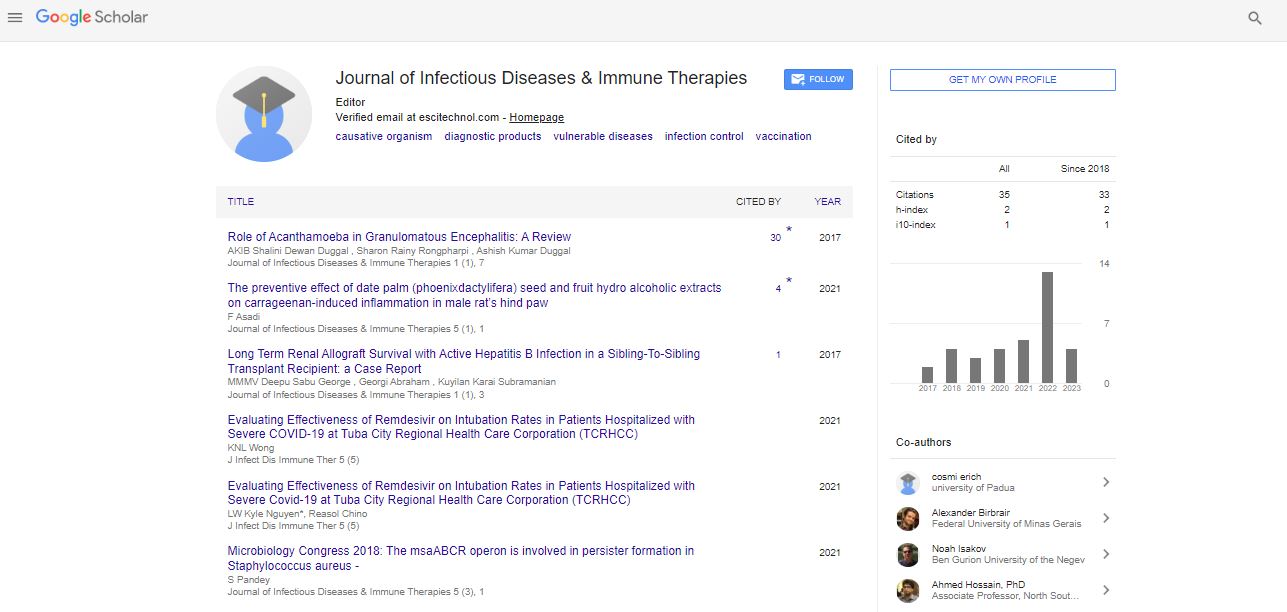Short Communication, J Aging Geriatr Med Vol: 7 Issue: 3
Tuberculosis and its Control through Vaccination
Adrian Alves*
1Department of Global Health, Amsterdam University, Amsterdam, Netherlands
*Corresponding Author: Adrian Alves,
Department of Global Health, Amsterdam
University, Amsterdam, Netherlands
E-mail: alves.a34@amsterdamumc.nl
Received date: 28 August, 2023, Manuscript No. JIDITH-23-117446;
Editor assigned date: 30 August, 2023, PreQC No. JIDITH-23-117446 (PQ);
Reviewed date: 13 September, 2023, QC No. JIDITH-23-117446;
Revised date: 21 September, 2023, Manuscript No. JIDITH-23-117446 (R);
Published date: 29 September, 2023, DOI: 10.4172/2329-9541.1000354
Citation: Alves A (2023) Tuberculosis and its Control through Vaccination. J Infect Dis Immune Ther 7:3.
Description
Tuberculosis (TB) is one of the world's oldest known diseases, with evidence of its presence dating back thousands of years. The bacterium responsible for TB, Mycobacterium tuberculosis, was discovered by Dr. Robert Koch in 1882. This innovative discovery marked the beginning of a long and arduous journey toward understanding and controlling the disease. The history of tuberculosis is deeply intertwined with human civilization. Ancient Egyptian mummies display signs of TB infection, and references to the disease can be found in various historical texts. It was often romanticized in literature and art as the "white plague" or "consumption," reflecting its devastating impact on individuals [1]. In 1882, Dr. Robert Koch made a pivotal breakthrough when he identified Mycobacterium tuberculosis as the causative agent of TB. His work laid the foundation for the understanding of infectious diseases and the development of diagnostic tools. Early treatments for TB were ineffective, often consisting of prolonged stays in sanatoriums [2]. However, in the mid-20th century, the discovery of antibiotics, particularly streptomycin, marked a turning point in the treatment of TB [3]. The disease that was once considered a death sentence became curable. Despite significant progress in TB treatment, challenges in controlling the disease persist. Drug-resistant strains of Mycobacterium tuberculosis have emerged, making treatment more difficult [4]. Additionally, the association between TB and HIV has complicated efforts to control the disease in regions with high HIV prevalence. Today, TB control strategies encompass a multifaceted approach [5,6]. This includes early diagnosis, directly observed treatment, and measures to prevent the spread of the disease. Various organizations, such as the World Health Organization (WHO), play a pivotal role in coordinating global efforts to combat TB. Developing a TB vaccine faces several challenges, including the complexity of the immune response to M. tuberculosis, the lack of reliable animal models, and the need for large and costly clinical trials. Additionally, the extensive global infrastructure for BCG immunization presents logistical challenges in introducing new vaccines [7]. BCG vaccination has been a mainstay of TB control efforts in many countries. It offers protection against severe forms of childhood TB, particularly miliary and meningeal TB. Although it's not as effective against adult pulmonary TB, it plays an important role in curbing the spread of the disease in endemic regions. While BCG is valuable, it has its limitations. It doesn't provide consistent protection in adults and offers no protection against latent TB infection, the most common form of TB worldwide [8]. Furthermore, BCG's effectiveness varies depending on factors such as age, geography, and exposure to mycobacteria. These limitations have spurred ongoing study for alternative TB vaccines. Several experimental TB vaccines are under development, aiming to enhance and complement the protective efficacy of BCG. These vaccines are designed to target different aspects of the immune response to M. tuberculosis [9]. Promising candidates include subunit vaccines and viral vector vaccines. Subunit Vaccines contain specific antigens from M. tuberculosis, designed to stimulate a focused immune response. Candidates like M72/AS01E and H4:IC31 are in advanced clinical trials and have shown promise in preventing TB. Viral Vector Vaccines use viral vectors to deliver TB antigens into the body [10].
Conclusion
The journey of tuberculosis, from its discovery to control, is a testament to human progress and resilience. While significant strides have been made in understanding and treating the disease, the battle against TB continues. Tuberculosis remains a formidable global health threat, and vaccination continues to be a vital component of TB control efforts. While the BCG vaccine has played an important role in protecting against severe forms of TB, it is not a panacea. Ongoing study into new TB vaccines offers hope for enhanced protection and the eventual eradication of this ancient disease.
References
- Rangaka MX, Cavalcante SC, Marais BJ, Thim S, Martinson NA, et al.( 2015 ) Controlling the seedbeds of tuberculosis: diagnosis and treatment of tuberculosis infection. The Lancet 386(10010):2344-53.
- Jasmer RM, Nahid P, Hopewell PC. (2002) Latent tuberculosis infection. N Engl J Med 347(23):1860-6.
- Getahun H, Matteelli A, Chaisson RE, Raviglione M. (2015) Latent Mycobacterium tuberculosis infection. N Engl J Med 372(22):2127-35.
- Sakamoto K. (2012) The pathology of Mycobacterium tuberculosis infection. Vet Pathol 49(3):423-39.
- Horsburgh Jr CR, Barry III CE, Lange C. (2015) Treatment of tuberculosis. N Engl J Med 373(22):2149-60.
- Murray JF, Schraufnagel DE, Hopewell PC. (2015) Treatment of tuberculosis: A historical perspective. Ann Am Thorac 12(12):1749-59.
- Abdool Karim SS, Naidoo K, Grobler A, Padayatchi N, Baxter C, et al. (2011) Integration of antiretroviral therapy with tuberculosis treatment. N Engl J Med 365(16):1492-501.
- Brodie D, Schluger NW. (2005) The diagnosis of tuberculosis. Clin Chest Med 26(2):247-71.
- Lange C, Mori T. (2010) Advances in the diagnosis of tuberculosis. Respir J 15(2):220-40.
- Ginsberg AM, Spigelman M. (2007) Challenges in tuberculosis drug research and development. Nat Med 13(3):290-4.
 Spanish
Spanish  Chinese
Chinese  Russian
Russian  German
German  French
French  Japanese
Japanese  Portuguese
Portuguese  Hindi
Hindi 